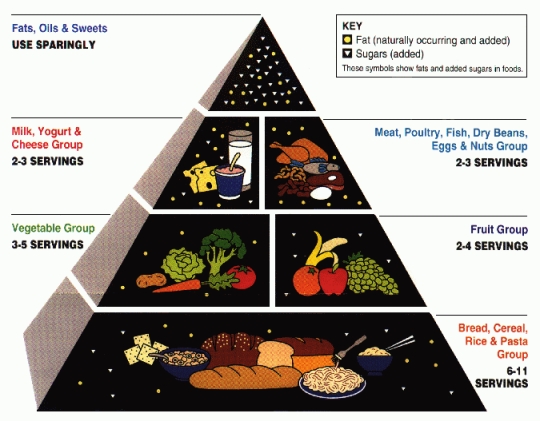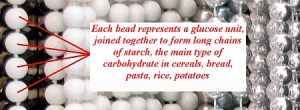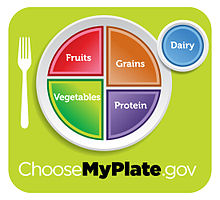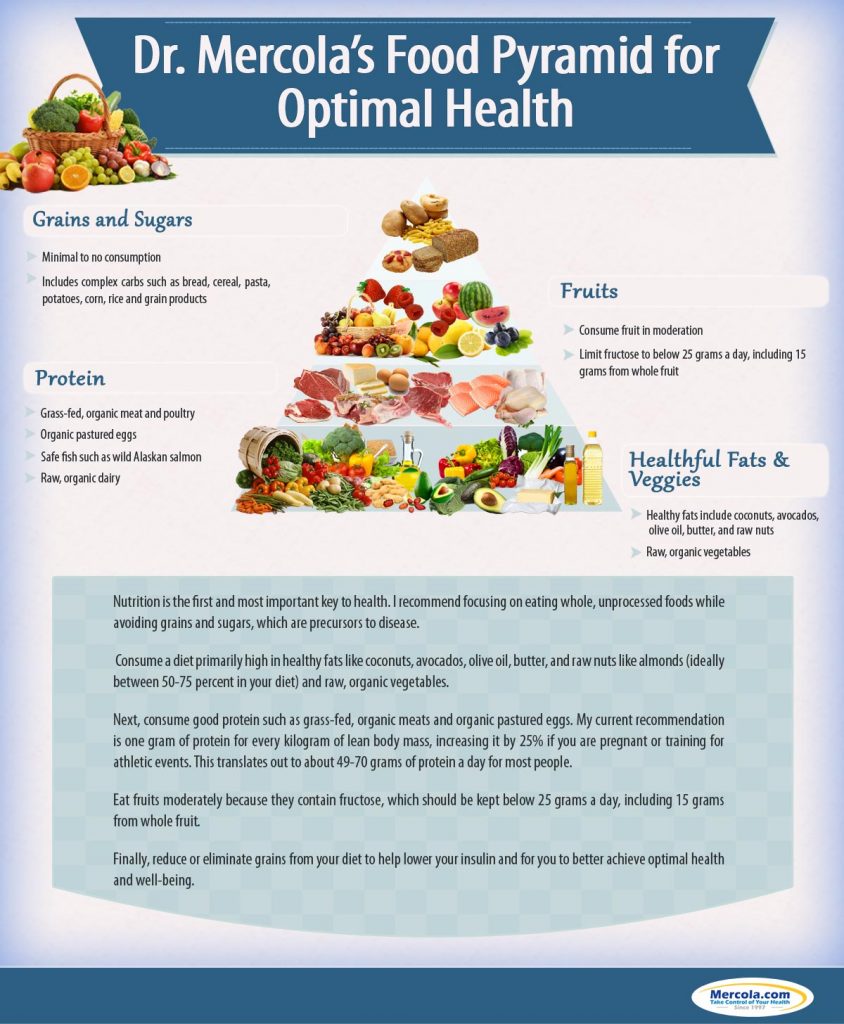This is an introduction to starchy carbohydrates, how they affect our blood sugar level, our insulin level, the amount of fat in our blood… and the fat stored around our waist and hips.
Carbohydrate
The original USDA food pyramid in 1992 had at its base the recommendation to eat as many as eleven servings of dense carbohydrates every day. Foods such as bread, pasta, maize, potatoes, and rice.

Dry beans featured in the protein section. Beans do contain protein, but the protein comes wrapped in carbohydrate. And if you buy beans in a can instead of cooking them yourself, the sauce usually contains sugar, which you’ll find listed in the ingredients panel on the label.
Starch
All the foods at the base of the USDA pyramid contain mainly starch.
And as you can see if you visit the starch Wikipedia page, starch is composed of long chains of glucose molecules.
To simplify the chemistry, imagine starch as strings of beads laid side-by-side, with each bead representing a glucose unit.

While you’re chewing a bite of whole-grain bread, a digestive enzyme in saliva called amylase, starts working on the starch in the bread, breaking the connection between each glucose unit.
After swallowing the chewed bread, amylase in the intestines continues its work, further breaking the joins between the glucose units. As each glucose unit is set free, it is absorbed into your blood stream.
Glucose storage
Some of that absorbed glucose is used by your brain for fuel. Some is used by your cells for energy. And depending on how active you are after your meal, some is used to power your muscles.
If all the glucose is not used, the liver makes glycogen by joining the unused glucose molecules together. Humans store glucose by turning it into glycogen. Plants store glucose by turning it into starch.
Our glycogen stores are located in our liver and in our muscles.
Here’s a very good short animated video from TED-Ed showing the process I’ve just described.
Triglycerides
Actually, the amount of glycogen that can be stored in the liver and muscles is quite small, and it doesn’t take much to fill the stores.
When the glycogen stores are full, the liver has no choice but to convert surplus glucose to a fat called triglyceride.
Some of the triglyceride is used by various body tissues, some is stored in the liver itself, and some is sent for storage in our fat cells.
The article ‘How added sugar harms us and what to do about it‘ has more information about the detrimental health consequences of making a lot of triglyceride.
vLDL
As you know, blood is a watery fluid, and fat and water don’t mix. The liver has a method to overcome this: it wraps the fat molecules with special protein transporter-molecules (which do mix with water) and releases them into the bloodstream.
These fat-plus-protein units are called very low density lipoprotein, or vLDL for short.
When your doctor tests your blood, the vLDL particles are listed on your test results as triglyceride. Here in Malaysia, a level more than 1.7 mmol/L is flagged because a high level of triglyceride in our blood is a known risk factor for cardio-vascular disease.
Incidentally, a high triglyceride level is often accompanied by a low HDL level (so-called ‘good’ cholesterol), and a raised LDL level (so-called ‘bad’ cholesterol).
This particular trio of high triglycerides, low HDL, and high LDL increases significantly the risk of cardio-vascular disease, and calls for an urgent change to what you’re eating and drinking.
Reduce triglyceride
The easiest way to reduce the amount of triglyceride in our blood (and thereby reduce our risk of cardio-vascular disease) is to reduce the amount of glucose our liver needs to convert to triglyceride.
And the simplest and most effective way to reduce the amount of glucose the liver has to deal with, is to reduce the amount of starchy carbohydrates and sugary drinks we consume.
FatHeadMovie made an excellent short video explaining this, and I’ve added it to Thrive Low Carb’s YouTube playlist.
If you’re not fat, don’t let the title put you off. The video is a clear explanation of how sugar and insulin work inside every human. Well worth three minutes of your time to watch it.
The biochemistry of blood glucose
If you’re interested in the science, this video by Dr Kieron Rooney, a biochemist at the University of Sydney, is an understandable explanation (with walk-you-through-it slides) of how and why excess glucose gets converted to fat.
Normal blood sugar level
The normal level of sugar in the blood is surprisingly low. The average amount of glucose in the bloodstream of a healthy adult is only 5 gm or so… about one teaspoon.

And of course, for children with their much smaller bodies and blood volumes, it’s much less than one teaspoon.
Receptors in our bodies are constantly measuring the level of glucose in our blood, and adjusting the amount to keep it within this 5 gm safe range.
If the level goes much below 5 gm, our liver gets a signal to convert some stored glycogen back into glucose, and to release the glucose into the bloodstream to bring the level back up to 5 gm again.
If there’s more than 5 gm, our pancreas gets a signal to make a hormone called insulin to take the excess glucose out of our blood stream and bring the level down to 5 gm again.
Insulin over-production
Your next meal may be starchy-carbohydrate based, and possibly the one after that, too. Including the carbohydrate between-meal-snacks, and the sugar-laden fruit juices and fizzy drinks, your pancreas has a very busy day trying to make enough insulin to deal with all those glucose molecules.
Over a period of years, swallowing an abundance of starch-laden meals, snacks, and sugary drinks stresses the control systems.
Chronically high blood glucose, with resulting chronic over-production of insulin, leads to insulin resistance, metabolic syndrome, weight gain, and type 2 diabetes.
And along the way, the misery of a long list of debilitating ailments like this Wikipedia list of lifestyle diseases:
- Alzheimer’s
- arthritis
- asthma
- blocked arteries
- cancer
- chronic liver disease
- chronic obstructive pulmonary disease
- dementia
- depression
- heart disease
- chronic kidney failure
- osteoporosis
- stroke
- obesity
MyPlate
As a result of mounting medical evidence, the USDA’s first food guide pyramid of 1992 was replaced in 2005 with MyPyramid, and again in 2011 with MyPlate.
MyPlate is divided into sections of approximately 30 percent grains (glucose), 30 percent vegetables (glucose + fibre), 20 percent fruits (glucose + fructose + fibre) and 20 percent protein, accompanied by a smaller circle representing low-fat/no-fat dairy (fat is often replaced with sugar, i.e. glucose and fructose).

MyPlate appears to be a re-hash of the old dogma of low fat and loads of glucose-producing carbohydrate.
And that has done nothing to reduce the world-wide epidemic of lifestyle diseases. In fact, a growing number of doctors believe it is the cause of the epidemic.
If the government recommendations were like this food pyramid from Dr Joseph Mercola, the epidemic of lifestyle diseases could be halted, misery and suffering avoided, and billions in health costs saved.

Summary
These are just some of the many benefits of replacing most of the starchy carbohydrates on your plate with a variety of leafy vegetables:
- lose weight and centimetres from your waist and hips
- enjoy more energy and mental concentration during the day
- improve your diabetes (more about this in the post ‘How to control diabetes naturally‘)
- lower your high blood pressure
- reduce your risk of cardiovascular disease
Questions? Comments?
If you’ve got any questions or comments, please type them in the comment box below.
Alternatively, if you prefer email, my email address is on the Contact page.
Either way, I’ll do my best to help you and will reply promptly.
————————————————–
Please note…
Important caution for people with diabetes, high blood pressure, swollen ankles, or expecting a baby
Please read the important medical advice at this page, before you start a low-carb, healthy-fat lifestyle.
————————————————–

Pingback: How added sugar harms us and what to do about it | Thrive Low Carb
Pingback: Blood tests and the LCHF lifestyle | Thrive Low Carb
Pingback: Why we get fat | Thrive Low Carb